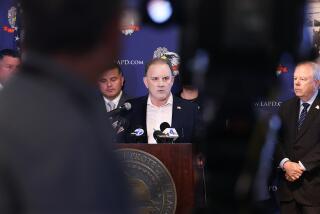Union Says Paper Won’t Practice What It Preaches
A bitter dispute over unionizing the LA Weekly’s advertising department has deeply divided journalists and managers at the traditionally pro-labor paper, leading some reporters there to question the state of alternative journalism itself.
Since 1989, the Weekly’s 50-odd editorial employees have been members of the International Assn. of Mahinists and Aerospace Workers, a union the paper’s original organizers chose because they regarded the Newspaper Guild as insufficiently assertive. Last May, members of the paper’s advertising staff--concerned about escalating sales targets, post-Sept. 11 layoffs and other job security issues--petitioned to join their colleagues’ local.
Given the Weekly’s unwavering editorial stance as a reportorial champion and unapologetic political ally of organized labor, employees were stunned when the paper’s recently appointed publisher, Beth Sestanovich, and her aides deployed every means at their disposal to try to defeat the organizing campaign.
As a consequence, this Friday’s representational election is deemed too close to call.
“This began as an ugly situation and has gotten increasingly that way,” said writer Erin Aubry Kap- lan, who is president of the Weekly’s union local. “I assumed--naively, I now realize--that the Weekly’s management would never oppose union organizing. However, they’re truly fighting us tooth and nail. It has been very disillusioning to people who assume the Weekly stands for the rights of working men and women.”
But Sestanovich said, “We believe that when you look at the highly individual and entrepreneurial work of advertising salespeople, union representation just isn’t in the interest of those employees. We coexist with our existing union without friction, and I know that it has surprised many of its members that we would contest extension of their union. But I feel strongly that every employee has a right to make a free and informed choice about this.”
David Schneiderman, president of New York-based Village Voice Media, which owns the Weekly and five other so-called alternative publications, did not return calls seeking comment.
Though labor-management relations at the Weekly have heretofore been amiable, the recent situations at other Village Voice Media properties have been different. Earlier this year, the Voice came within 24 hours of a strike, and a contentious organizing effort was defeated at the chain’s Cleveland Free Times. (For the record, the Los Angeles Times has no unionized employees and, for more than 100 years, has strenuously resisted any attempt at organization.)
The Weekly, however, regards itself as Los Angeles’ “progressive bible.” For many years, its labor reporting was the local gold standard, and its leading political commentator--the indispensable Harold Meyerson--played a leading role in chronicling the rise of organized labor in Los Angeles and, particularly, its contribution to Latinos’ social and political progress.
So it came as a shock when Weekly managers forced a representational election by rejecting card check organizing, the process by which a union is recognized if the majority of a bargaining unit’s members sign membership cards. Editorially, the Weekly is one of the nation’s strongest proponents of card check organizing.
Sestanovich said that she “insisted that there be an election because it wouldn’t be democratic or fair for me to assume unilaterally that everyone in a bargaining unit wants to join the union. I think each person should get the facts and decide according to their conscience. I know that disappoints some people around here. But while our editorial policy is pro-union, it also is pro-democracy. Sometimes I think some people would say that our editorial policy is anti-business. But I have no intention of interfering with what our editorial employees write, even though we, too, are a business.”
Sestanovich twice increased the size of the bargaining unit to widen the pool of potential voters to 29. Employees were instructed to attend mandatory meetings where--according to documents reviewed by The Times--they were told that voting for the union would imperil their existing pay and benefits.
In a note provided to The Times, Sestanovich told an advertising employee who had requested a salary discussion that she was legally precluded from talking about the issue until after the election. “If the union becomes your collective bargaining representative, neither the LA Weekly nor I will be in position to negotiate individually with you about your compensation....” the publisher wrote. “ ... Assuming that the union isn’t voted in, we can sit down promptly afterward and be in a position to discuss directly with you the status of your compensation.”
“It is the height of hypocrisy for this to go on,” said Weekly writer Howard Blume, who is the union local’s vice president. “The Weekly always has been associated with progressive politics and the promotion of the union movement in general. This paper has written article after article decrying the very union-busting tactics our management now is employing within our own building. Without our sense of social mission, this paper is nothing but an L.A. Magazine that comes out once a week on inferior, ink-bleeding paper.”
Children of the 1960s’ social ferment though they may be, so-called alternative papers have in recent years become less and less distinguishable from their conventional counterparts. Politics and social activism have frequently been nudged aside to make way for entertainment and soft-focus cultural journalism.
In fact, a major difference between many alternative weeklies and their “straight” competitors now is the former’s libertarian social views, which enable their publishers to accept lifestyle and sexually oriented advertising other media forgo. As a consequence, many alternative publications are capitalist cash cows. The Weekly, according to its staff members, has used cost-cutting and layoffs of nonunion employees to maintain a profit margin of more than 20%--a figure that would set even the eyes of Gannett Co. executives aglitter.
“I find this all very disillusioning and disheartening,” said Kaplan, the local president. “This has caused a lot of us to reassess this paper. We’re fine with our work, but our workplace has changed. We journalists truly feel an obligation to support organized labor, and if our paper doesn’t, it raises questions about who we are.”
Work in Progress
Fintan O’Toole, who lives in Dublin, is the Irish Times’ drama critic. He is the author of numerous books, including a biography of dramatist Richard Sheridan and, most recently, “Shakespeare Is Hard, but So Is Life,” which was just published in England:
“I’m embarked on a big project, which I think will turn out to be a series of books about Ireland and American popular culture. It’s an attempt to unwrap the origins of important American myths about America. I have a notion that the sources of most influential American myths are elsewhere because you are an immigrant culture and that it might be valuable to start retelling some of those stories from their ‘elsewhere’ of origin, if you will.
“So, this first book is about a man called Sir William Johnston, who was from a little village about 30 miles north of Dublin and who went to what is now New York state in the 1730s and became an Iroquois Indian. He was from a Catholic family that had married into the Protestant gentry to hold on to their land--not an uncommon event in Ireland at the time. His Protestant uncle had an interest in the North American fur trade, and Johnston went over to help out. He quickly established himself among the Iroquois because he traded fairly, and he married into their Mohawk band, an advantageous alliance, since they were essentially the middlemen in the great fur trade. At the time, the Iroquois Confederation was a major North American military and economic power, and dealing with it was a major preoccupation of British diplomacy. Johnston became an incredibly important figure in that process.
“He built a great Georgian mansion not too far from Niagara. This book will deal with his role as a conduit for the idea of the wilderness as a thing to be exploited and civilized, and with the romantic and heroic figure he became as a consequence. He was also a very early example of what we’ve come to think of as American multiculturalism--an Irish man who was made a British baronet and yet thought of himself, at least some of the time, as an Iroquois, who often wore their native dress. His is what we now think of as the typical American story, one that has made American culture so powerful around the world.”
More to Read
Inside the business of entertainment
The Wide Shot brings you news, analysis and insights on everything from streaming wars to production — and what it all means for the future.
You may occasionally receive promotional content from the Los Angeles Times.










